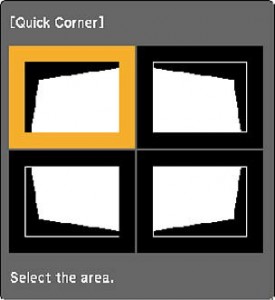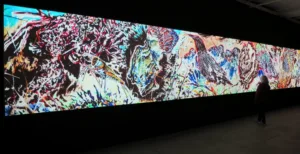Currently there is an installation of the Chinese artist Sun Xun’s work using four Epson G6750WU projectors at the Sean Kelly Gallery in New York. Meko has posted the Epson press release on this installation but I wanted to visit the gallery to see how an actual multi-projector installation looks. I’ve see many installations at trade shows such as InfoComm where everything was perfect and the multi-projector installation was done by the manufacturer’s own technical people. I wanted to see how an installation like this worked in real-life, not just a trade show.
Sun Xun’s animations projected on a 50’ screen by a blend of four Epson G6750WU projectors at the Sean Kelly Gallery.
While at the gallery I had a chance to talk to Janine Cirincione and Ben Polsky, Director and head technician for the gallery respectively. Cirincione was also curator for the exhibition. They told me that the gallery personnel plus Sun Xun and his assistants did the installation, not Epson. Nor was there a Pro-AV company involved in the installation or set-up. Cirincione told me that the artist had specifically asked for the Epson G6750WU projector, in part because he had worked with it in previous installations. Epson supported the installation by supplying the projectors.
The Epson G6750WU projector is a 3LCD projector that was first shipped in June 2013 and has a $5,999 MSRP. It has WUXGA (1920 x 1200) resolution, 6000 lumens of both white (ANSI) output and color light output (CLO), a 2000 hour 380W UHE lamp (4000 hours in Eco mode) and a specified 5000:1 contrast. The fact that color and white lumens are identical improves color rendering, an important property for an art installation such as this. It is normal for three panel projectors whether based on LCD or DLP technology to have identical Color and White lumens, but single panel projectors often have a significantly lower CLO value compared to white (ANSI) lumens.
Several features of the projector were needed for the installation, including built-in edge blending and lens shift. The projectors were ceiling mounted, and the projection lens shift allowed rectangular rather than trapezoidal images to be projected on the screen.
 Quick Corner, as depicted in the Epson G6750WU owner’s manual
Quick Corner, as depicted in the Epson G6750WU owner’s manualOne feature of the Epson G6750WU Polsky said simplified installation was the “Quick Corner” feature in the software. This allows the installers (i.e. Polsky and his counterpart on Sun Xun’s team) to adjust the images quickly to abut the adjacent images visually. From the remote control, you can select this feature from the menu, select the corner you wish to adjust, adjust the corner with the up/down/left/right arrows on the remote and then go on to the next corner. Polsky said the installation had been stable since it had been open to the public on January 8th and he had done no corrective tweaks. He also said he hadn’t needed to change any lamps and the projectors had been used not only for the public showing but before that while the artist was in residence. While in residence, Sun Xun generated the work on paper, converted it to video and previewed the results on the projectors.
In addition to the Epson projectors, the artist used a Dell PC with a VisionTek Radeon HD 7750 Eyefinity 6 2GB GDDR5 Graphics Card as a host computer and connected the projectors to the computer via HDMI. – Matthew Brennesholtz

